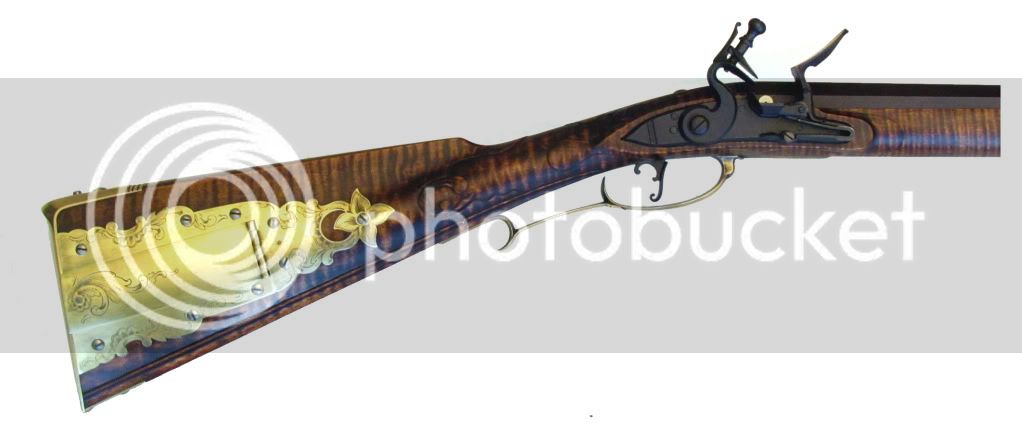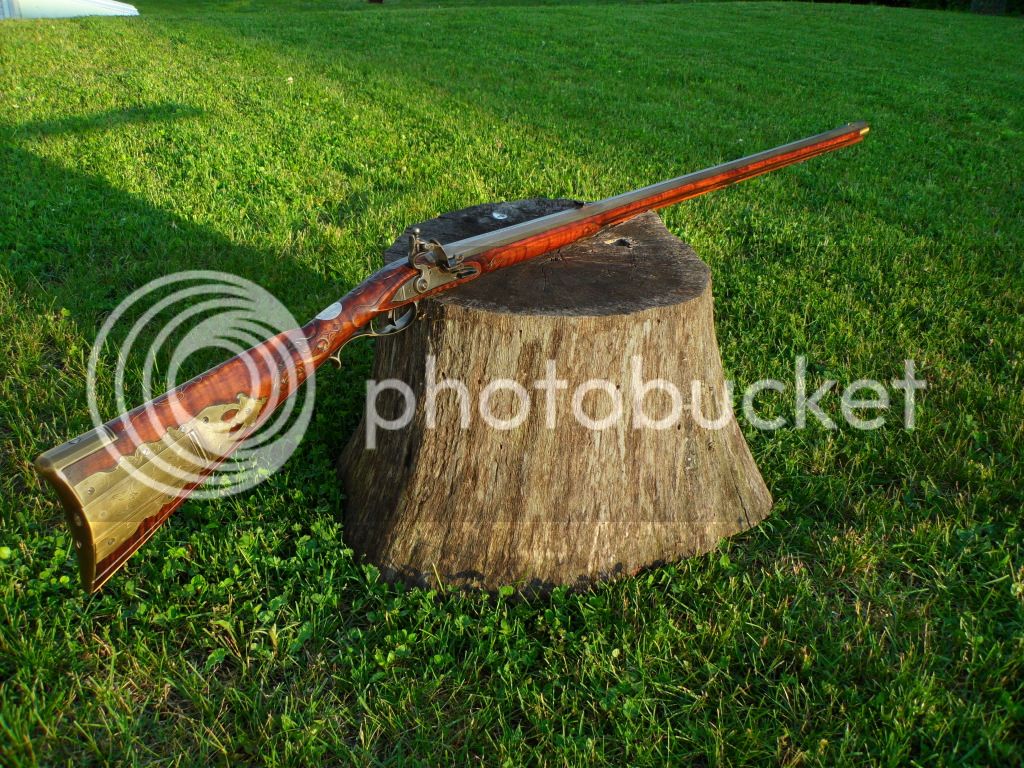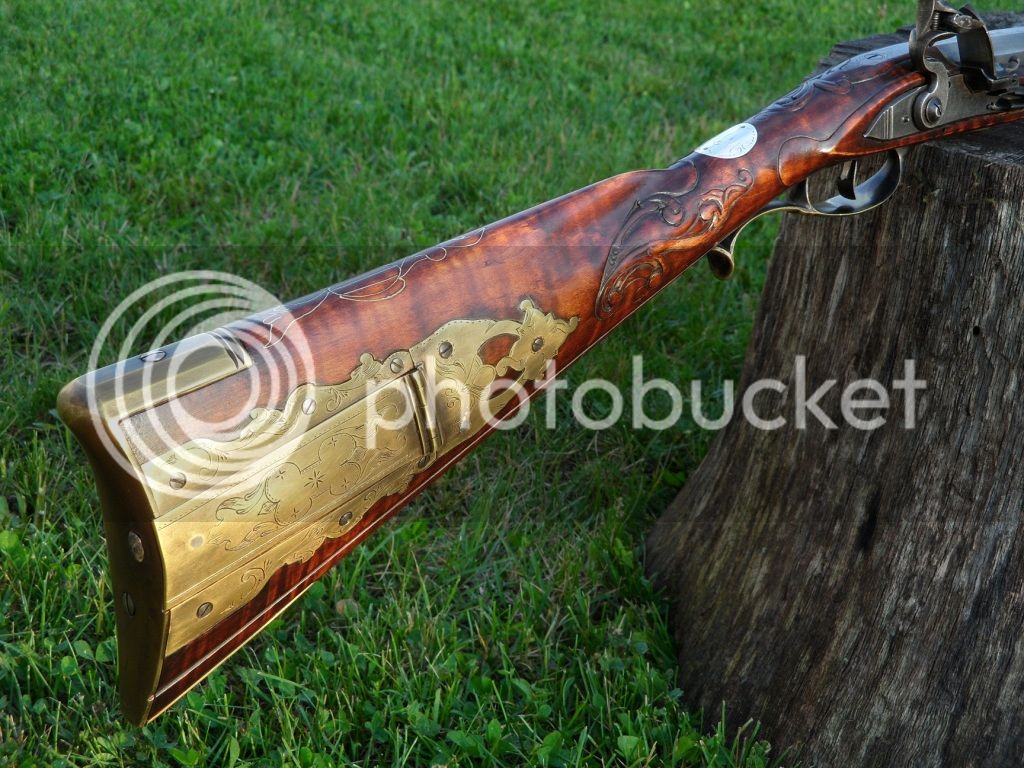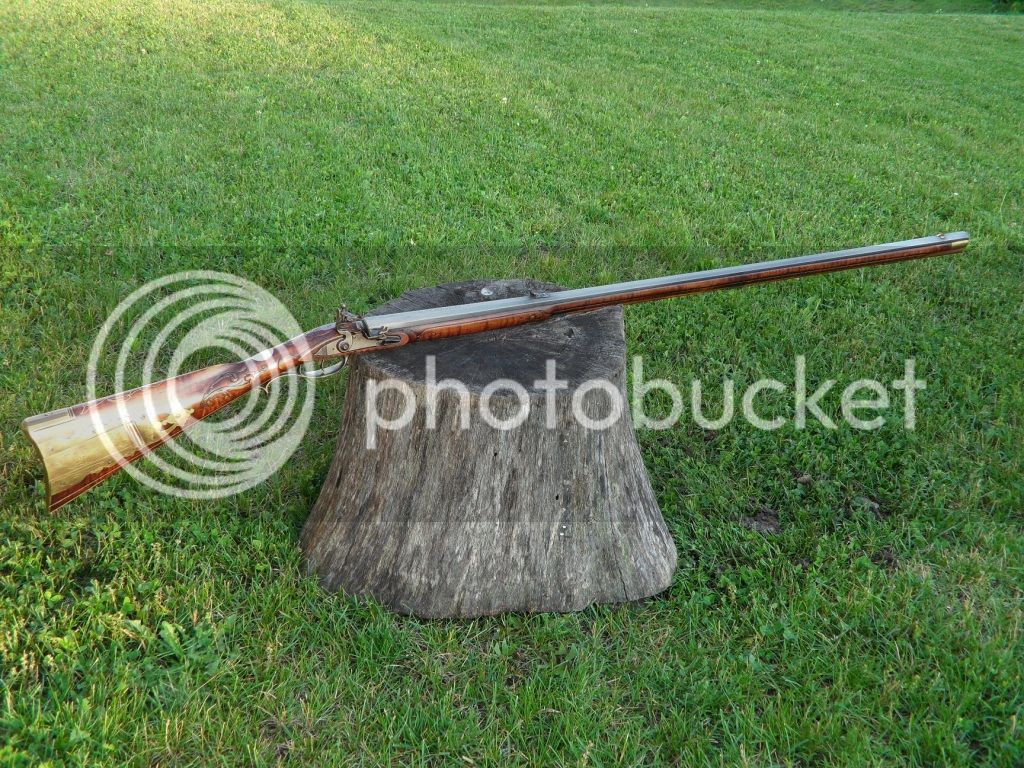I did not say anythig was wrong with your gun, I was asking about the comparison twixt the size of the tg on the Morovian gun and that on some other early guns of other styles,as I saw a great difference,and thought it was intersting that they would vary so much as I believe the Morovians started and kind of kicked of the Penn /Lancaster styles like in Christian Springs and are though to have influence a gtreat deal of the longrifle evolution. I do not have the book you have that shows Monrovian guns from the 1750-60 period which is what I understood it to be as it is from the early range of 1750-1780. As I said it will take someone else to try and put this into a form you can relate to as I am evidently unable and have lost interest at this point as he more I look the more I see or don't see so there is no reason to continue trying to compare features of the 1750-60 Morovian guns and the pre rev war/early rev war Lancster or Virginia guns, I see others have been smarter than I and not got envolved, I see now it was a mistake on my part.
-
Friends, our 2nd Amendment rights are always under attack and the NRA has been a constant for decades in helping fight that fight.
We have partnered with the NRA to offer you a discount on membership and Muzzleloading Forum gets a small percentage too of each membership, so you are supporting both the NRA and us.
Use this link to sign up please; https://membership.nra.org/recruiters/join/XR045103
You are using an out of date browser. It may not display this or other websites correctly.
You should upgrade or use an alternative browser.
You should upgrade or use an alternative browser.
Lets see some of those Long Rifles!
- Thread starter Ash Eyler
- Start date

Help Support Muzzleloading Forum:
This site may earn a commission from merchant affiliate
links, including eBay, Amazon, and others.
I guess that all makes sense to you, it makes none to me. I'm done!
Robby
Robby
jdkerstetter
69 Cal.
- Joined
- Feb 15, 2012
- Messages
- 3,029
- Reaction score
- 7
Hey Robby,
You know I'm a fan. Love this gun. Nice work. Especially like your clean work (as is the usual for you) and the color you managed to achieve on this peice.
I almost didn't want to comment though as it appears I agree with Roundball for once.
I hope I can help you and TG out though...he is a good guy and I really believe he is sincere in his questioning.
When he is referring to the open area behind the trigger guard he is referring to the grip-rail.
I don't have the Morovian book yet...don't know why...so can't make comparisons based on it.
I think TG is thinking back to the Christian Spring's guns in RCA I Nos. 41-46. The grip rails on those early guns are fairly straight and stand away from the underside of the stock more than later guns. That being said, I find that No. 46 does have a slight upsweep approaching what you have depicted so nicely here.
Keep up the great work. I look forward to seeing more and would really like to see this and your long slender Southern piece in person some day.
Enjoy, J.D.
You know I'm a fan. Love this gun. Nice work. Especially like your clean work (as is the usual for you) and the color you managed to achieve on this peice.
I almost didn't want to comment though as it appears I agree with Roundball for once.

I hope I can help you and TG out though...he is a good guy and I really believe he is sincere in his questioning.
When he is referring to the open area behind the trigger guard he is referring to the grip-rail.
I don't have the Morovian book yet...don't know why...so can't make comparisons based on it.
I think TG is thinking back to the Christian Spring's guns in RCA I Nos. 41-46. The grip rails on those early guns are fairly straight and stand away from the underside of the stock more than later guns. That being said, I find that No. 46 does have a slight upsweep approaching what you have depicted so nicely here.
Keep up the great work. I look forward to seeing more and would really like to see this and your long slender Southern piece in person some day.
Enjoy, J.D.
Tumblernotch
69 Cal.
- Joined
- Feb 26, 2005
- Messages
- 3,370
- Reaction score
- 11
Number19 said:I need to add that the Upper Valley of Virginia did also have a strong history of English influence on rifles. Adam Haymaker produced extraordinarily fine rifles from about 1753 until his death in 1808, and lived in Winchester. Winchester was at a crossroads with migration routes leading in all four directions.
I don't mean to sound like I'm nitpicking, but in case someone wants to research gunmaking in the Shenandoah Valley, it should be noted that the northern end of the Valley is in fact the Lower Valley. Just in case someone was to google or otherwise look up Virginia builders.
Robby....beautiful LR as are all your rifles. The TG looks good to me and melds in w/ the wrist and lock area. I think what tg is talking about is that the grip rail is too curved and isn't far enough away from the toeline. I don't see anything wrong whatsoever w/ your TG but here's an example of an "early" TG w/ a straight grip rail that's quite far from the toeline.....Fred


Fred, Another beautiful Gun!!! Yes, I understand that on some of the early guns they had used the straight grip rail, a feature I never could warm up to. But, there are examples of early Moravian guns with a curved rail as I cited. Mine is not a bench copy, just an interpretation of how I see those guns. What I tried to do is pretty much as you describe it Fred, thank you. A larger issue would be the angle of butt plate, maybe something to chew on at a later date. I'll just say, I gave it a few degrees of rake, with more comfortable shooting in mind, and it is.
Robby
Robby
hanshi
Cannon
Robby, Your workmanship really shows on that gun. You are to be congratulated. :hatsoff: :hatsoff:
It is not nitpicking. This is something which needs to be gotten straight. I'd like to see something documenting your comment.KanawhaRanger said:I don't mean to sound like I'm nitpicking, but in case someone wants to research gunmaking in the Shenandoah Valley, it should be noted that the northern end of the Valley is in fact the Lower Valley. Just in case someone was to google or otherwise look up Virginia builders.
I am referencing Kentucky Rifles & Pistols 1750-1850. Shepardstown, Berkeley Co (now West Virginia) and Winchester, Frederick Co are referred to as Upper Valley School. This area, I think, doesn't actually drain into the Shenandoah River, but is geologically part of the Shenandoah Valley. This is the area that I mentally picture when I speak of Upper Valley.
This same reference refers to Stanton as being Upper Valley. I've never seen the use of the term "Lower Valley" when identifying longrifles, but it would be logical to refer to this as "lower valley" to distinguish it from Berkeley and Frederick Counties. But members of the Sheetz family Upper Valley school moved to Staunton and continued their family's style of rifle at this location.
The southern end of the Valley of Virginia, south of Staunton, is geologically part of the Shenandoah Valley, but actually drains south into the James River. Immediately south of the geological Shenandoah region is an area which is culturally part of the Shenandoah area, but again is part of the James River Basin. This information comes from this source : http://www.flintriflesmith.com/WritingandResearch/WebArticles/VirginiaRifle.htm
Anyways, when I refer to the Upper Valley school, I am referring to the gunsmiths of Shepardstown and Winchester.
Last edited by a moderator:
I just remembered that I did run across the use of "Lower Valley" and was confused. I finally decided what they were referring to was the eastern edge as opposed to the western edge, of the Valley. Since the Valley actually runs NE toward the SW, the east edge might be referred to as the lower edge - or Lower Valley. I guess? But it is kinda Orwellian to refer to the North end as the Lower end. (edit) I get it. Referring to the flow of the river. The floor of the valley slopes south to north.
After looking at "other" references, I would say that Kentucky Rifles & Pistols got it wrong. Whisker simply called it the Berkeley County School; I suppose I may have to start breaking it down into into the Berkeley, Jefferson, Frederick and Shenandoah County's Schools.
Does anyone have any other suggestions?
Does anyone have any other suggestions?
Okay, .201, or .199

Robby

Robby
Robby said:Okay, .201, or .199

Robby
220-221 whatever!! :grin:
Robby got say... your work makes me wanna shoot left handed.. :v
Mike Brooks
Cannon
- Joined
- Jul 19, 2005
- Messages
- 6,686
- Reaction score
- 33
I could never hit a ball anyway..... :idunno:makeumsmoke said:97 replys 17 pictures you guys are batting .200... :idunno:
I'd post a link to my stuff, but it would probably get zapped. Besides, you guys have all seen the junk I make anyway. :haha:
Lonegun1894
54 Cal.
- Joined
- Oct 2, 2005
- Messages
- 1,531
- Reaction score
- 17
Mike,
I for one would love to own a piece of your "junk" someday. Maybe when I grow up and quit having stuff pop up so I can save some money.
I for one would love to own a piece of your "junk" someday. Maybe when I grow up and quit having stuff pop up so I can save some money.
hanshi
Cannon
Robby, that's one fine longrifle. I know you're proud to be the owner; I would be.
Thanks Hanshi. I am not sure proud is the right word, but I do like the gun, and made a nice shot on a deer with it. I am never satisfied with anything I make, and have come to believe that is an asset. Humility is a good thing. :wink:
Robby
Robby
hanshi
Cannon
Robby, take my word for it; it's really hard to be humble when you're perfect. :rotf:
My newest rifle....
This is an interpretation of a known J.P. Beck rifle built for me by Ron Luckenbill.
44" Getz Lightweight swamped .54 barrel and a Stan Hollenbaugh "Beck" flintlock that was made using a cast of a lock from an original J.P.Beck rifle.
(After seeing very good pictures of the original that mine was based on, the 2 locks are VERY close)
The original is on display right now at the Landis Valley museum in Lancaster, PA and I have plans to go and visit it soon!
She's slim and trim and balanced beautifully!



This is an interpretation of a known J.P. Beck rifle built for me by Ron Luckenbill.
44" Getz Lightweight swamped .54 barrel and a Stan Hollenbaugh "Beck" flintlock that was made using a cast of a lock from an original J.P.Beck rifle.
(After seeing very good pictures of the original that mine was based on, the 2 locks are VERY close)
The original is on display right now at the Landis Valley museum in Lancaster, PA and I have plans to go and visit it soon!
She's slim and trim and balanced beautifully!



Similar threads
- Replies
- 20
- Views
- 990
- Replies
- 4
- Views
- 488
- Replies
- 23
- Views
- 842



